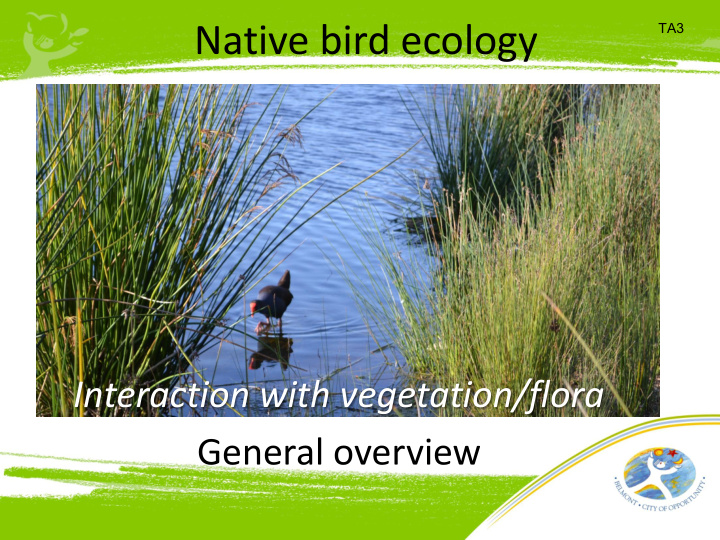



Native bird ecology TA3 Interaction with vegetation/flora General overview
TA4 History • Native flora and fauna evolved together over millions of years • Adapted to local soil and climatic conditions • Some relationships between native plants and animals are very specific, others are not • In WA, knowledge of relations between flora & fauna is not well documented • Generally, non-local plant species are used much less by animals
TA5 Use of flora by birds • Shelter, roosting & resting • Nesting • Food
TA6 Shelter, roosting & resting • Most bird species will roost or shelter in a wide range of plant species, as long as they provide cover • Others have marked preferences • Eg rufous night heron prefers trees with dense canopy (paperbarks, dense clumps of foliage inc pine trees). • Dead branches used by rainbow bee eater, swallows & tree martins also use power lines.
TA7 Nesting • Varies greatly between bird species • Some require tree hollows (trees 100+ years old) • Others use vertical forks in trees, horizontal branches or outer foliage
TA8 Food Most bush birds obtain food from trees/ shrubs either directly or indirectly – nectar, seeds, fruits, gum, insects/ insect larvae
TA9 Impact of European settlement silver gull welcome swallow magpie white-faced heron galah black-shouldered kite crested pigeon straw necked/ sacred ibises
TA10 Impact of European settlement yellow-plumed honeyeater freckled duck shoveller red-tailed black scarlet & yellow robins cockatoo red-winged fairy wren long-billed corella rufous tree-creeper brush bronzewing whistling kite white-breasted robin brown falcon
TA11 Carpark tree selection • Maximum canopy for shade in summer • Minimal leaf litter • Low risk of branch failure Correctly designing the site to enable a particular species to reach their full potential Maximise returns of financial investment associated with modified carpark design/ tree cells etc
TA12 Ideal attributes of carpark trees • Densely foliated spreading or round crown form as these cast the most shade • Good drought tolerance because of the high soil and air temperatures in car parks (even if soil stays moist), especially in narrow planters • Good crown structure with a low risk of branch failures • Winter deciduous trees are often preferred in car parks because of the dual benefit of providing cool summer shade and warm winter sun.
TA13 Suitability of native trees • Eucalypts are generally more open-crowned with less internal foliage and therefore cast less shade • More densely foliated natives are non-local sub- tropical species , i.e. Ficus spp. (hills figs), Lophostemon sp. (brush box), and Syzygium sp. (liliy pillies) • Agonis flexuosa (W.A. peppermint), native to south- west W.A., is not as densely foliated because of its narrow-leaved foliage, but generally more dense than most Eucalypts. But its smaller stature limits the extent of shade.
Suitability of local native tree TA14 species Jarrah Marri Flooded Coastal Banksias *Sheoaks Nuytsia Gum Blackbutt Small size and/or insufficient shade Slow growing Issues with quantity and size of litter Branch failure potential Variable size/ form Dieback Marri Dieback Dieback Dieback Susceptibility to canker pest and diseases Poor tolerance to root disturbance Dieback= Phytophthora cinnamomi
TA15 Centenary Park carpark tree selection Quercus rubra – Red oak Agonis flexuosa – W.A. peppermint c. 12 years c. 12 years
TA16 Attributes Red Oak WA Peppermint Quercus rubra Agonis flexuosa Predictable size and Good Good (somewhat variable) form Strong crown structure Excellent Good (low risk of branch failure) Crown form - leaf Rounded / spreading Broad-crowned pendulous density (willow-like) Height x width (m) 11 x 11 (20 yrs) 9 x 7 (20 yrs) 15 x 15 (30 yrs) 9 x 9 (30 yrs) Shading potential Very good to excellent Moderate to good (limited by height) Growth rate Moderately rapid Moderately rapid Litter Leaves fall in autumn – Moderate year-round leaf fall small acorns in late Seed capsules negligible summer
TA17 Attributes Red Oak WA Peppermint Quercus rubra Agonis flexuosa Resistance to pest and Very good Very good diseases Non-allergenic Yes Yes Tolerant of wide range Wide range of soils Yes – wide range of soils. Not of environmental except > pH 7.5 (alkaline tolerant of extended water conditions (pH, soil, soils). logging/anaerobic cond. moisture) Urban tolerant: partial Urban tolerant: partial compaction, pollution. compaction, pollution. Strong High Moderately-high compartmentalization response Aesthetic features Very good Good Non-invasive Yes Yes Long-lived (ULE) 100+ 50 – 70
TA18 Centenary Park vegetation Comparison Dec 07 – Dec 13
TA19 June 2009 June 2010
Recommend
More recommend